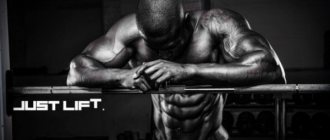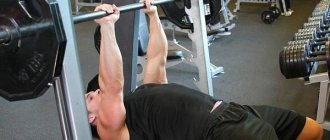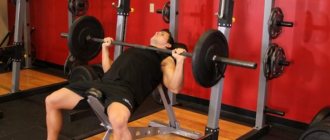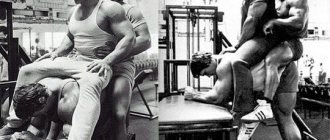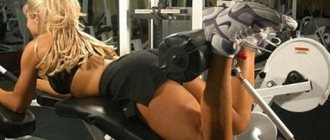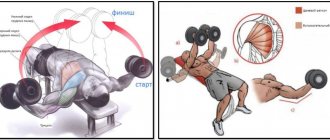Functioning muscles
The angled dumbbell bench press hits the same muscle targets as when using a barbell. In any case, the chest takes on the main load, additionally developing the deltoid muscle and triceps. Many other muscles play an auxiliary role in this exercise. The load varies depending on the position of the torso. When placed horizontally, the middle pectoral muscles are worked, the elevation of the torso allows you to load the upper chest, the reverse slope helps to work the lower part of the chest.
When gaining muscle mass, it is necessary to specifically work on the upper part of the body, since the lower chest is initially larger in volume. Barbell presses are not very suitable for inexperienced athletes who have recently entered the gym, and dumbbell exercises at different angles, fully engaging the top, bottom and middle of the pectoral muscles, are acceptable for athletes of any level.
Technical execution
Proper technique is important to the effectiveness of any exercise, including the dumbbell bench press.
The horizontal bench for pressing should be comfortable; you can put a towel under your head and back.
Technique:
- when placed on the apparatus, the pelvis, back and back of the head should not hang;
- your legs must be set at an angle of 50-60 degrees, resting on your heels;
- the position must be fairly stable, this is the only way to begin the task, and the placement must be remembered.
Dumbbells must be placed within reach. To perform the exercise, the apparatus must be placed on your knees. In a lying position, move the dumbbells closer to the chest area. Then straighten your arms, leaving a slight bend in the elbow. The handles of the projectile must be parallel, on the same line, and from this position a smooth downward movement is performed.
In the maximum possible position of the projectiles, a stretch should be felt in the pectoral muscles, from this moment a return to the original state is performed.
The warm-up approach involves 10-15 repetitions with light dumbbells. With each approach, the weights become heavier, 10 repetitions are performed.
Basic mistakes
• Incorrect bench angle. An inclination angle of more than 60 degrees will shift the emphasis to the deltas. • Lifting of the pelvis and head from the bench, excessive arching of the back in the lumbar and thoracic regions. This position places the load on the shoulders rather than the chest. • The point of descent of the barbell is slightly higher than during a bench press. Throwing a projectile onto the collarbone can result in bone injuries. The correct point is found experimentally: at the lowest point you need to hold your forearms perpendicular to the floor surface. • Squeezing the barbell until your arms are straight. When the arms are fully straightened, the load is redistributed not to the pectoral muscles, but to the triceps brachii. Therefore, it is important to keep your elbows slightly bent. • The projectile should be lowered and squeezed out at an angle. Vertical movement places extra stress on the shoulder muscles, which increases the risk of injury. • When working with heavy weights, it is recommended to have a spotter. • Number of repetitions: 3 sets of 10-12 repetitions • Weight: The working weight is selected so as to repeat the bench press 10-12 times
Number of repetitions
: 3 sets of 10-12 repetitions
Weight
: The working weight is selected so as to repeat the bench press 10-12 times
Changing the inclination angle
This position differs from the horizontal position by a modified backrest tilt and movement of the dumbbells; the degree of the bench is set to 30-45 units.
The angle exercise is useful after the basic barbell exercise.
Changing the tilt is possible not only to the upper position, but also to the lower one. Here the angle is also set to 30-45 degrees.
Technically, all types of tasks are performed in the same way. However, there are nuances:
- When placed upside down, the position is unstable, so it is recommended to slightly raise the edge of the machine. To do this correctly comes with experience.
- Despite the change in angle, the dumbbell movements should remain in the vertical axis. Thanks to the correct technique, the loaded pectoral muscles change.
- When inclined, it is recommended to spread your legs wider, which will add stability.
- Particular attention should be paid to the technique when positioned upside down.
Due to this condition, blood rushes to the head, which affects intracranial pressure. In poor health, athletes feel dizzy and have dark vision. The exercise is absolutely not suitable for older people. Being upside down is not very convenient for picking up dumbbells, so you need to ask for help in advance.
| with your head tilted up | 10–15 times, 3-4 approaches |
| with head down | 10 times, 1 set |
| horizontal placement | 10-15 times, 3 sets |
| fitball placement | 15 times, 1 set |
For the result of the movement in an inclined state, a few working repetitions are enough, and it is necessary to work with a small weight. After finishing the press from a head down position, you need to get up slowly. Dizziness may occur with sudden movements.
What are the benefits of the dumbbell press?
Let's figure out why the bench press with dumbbells is so good. Why is it often preferable to the same basic barbell press?
In what cases is it necessary to press dumbbells on an incline bench, and when is it better to press on a horizontal bench?
Easy start for beginners
When you're at the gym for the first time, there's no point in lifting a barbell. Your body has not yet mastered the technique, and your muscles will not be able to fully contract to complete all the repetitions.
The Olympic bar weighs 20 kg, which can be a lot for the first bench press in life. Dumbbells will allow you to practice your technique with light weights, which is very important at first.
Over time, the weights will increase, and it will become possible to switch to a barbell. But even in this case, you should not forget about dumbbells. For example, you can perform a dumbbell bench press lying on an incline bench (or a horizontal version) after a barbell bench press.
The ability to “clog” muscles
After heavy basic exercises, you need to squeeze out the remaining strength from the muscles. Doing this with a barbell is sometimes too difficult. A beginner may not have enough strength to handle an empty 20 kg bar. Therefore, you can refine the muscles of the chest, shoulders and triceps using dumbbells.
The dumbbell incline press is a good last exercise in this case. After all, if the fly can only use the chest and part of the deltoids, then pressing dumbbells at an angle and horizontally allows you to distribute the load over the entire chest, triceps and anterior deltoid muscles.
For a full feeling of “refusal”, you can work with light weights 15–20 times in 2 approaches. The muscles will burn incredibly, followed by a proper feeling of fatigue.
No attachment to place
The point is that to press a barbell you need racks, you need a barbell. There is no mobility. It's the same with dumbbells.
The dumbbell bench press on a horizontal bench is the simplest in this regard. Just look for a bench. And you can bring dumbbells to her anywhere. At home, you can use stools lined up in a row. Lay down and work.
If you do the exercise in the gym, you don’t need to remove the weights from the dumbbells and put on new ones. If you plan to train with several weights, just place them next to each other. Once you’re done with some, you can immediately take others and do supersets, circuit training, etc.
If you plan to do a dumbbell bench press lying on a bench with a positive incline, or, conversely, upside down, it will be a little more difficult. Here you need an inclined bench. However, there are usually several of them in gyms, so this should not be a problem.
The advantage of split weight
When you press a barbell, the weight is distributed evenly between both hands. The downside to this event is that if one arm is weaker than the other, you may not complete the exercise. Because one hand will lag behind. And the second one is not able to squeeze the entire barbell - it’s hard.
When you work with dumbbells, each hand handles its dumbbell one on one. That is, if one arm is weaker, this will not prevent the other arm from pressing the weight.
In addition, when you work with dumbbells, you spend more energy holding the weights. Since each hand carries its own weight, you can easily lose your balance. If one hand does not have enough strength to squeeze the dumbbell, you are immediately unbalanced. Therefore, balance stabilizers are intensely strained and strengthened during such exercises.
When you do incline dumbbell bench presses (45 and 30 degrees), most of the weight is distributed between your heels and your pelvis. This position is more stable than lying on a horizontal bench.
Faulty technique
The main thing is to try to avoid the following:
- Do not choose dumbbells that are too heavy; with them the movements will be jerky, which is wrong. This way, not only can you not achieve stabilization, but you can also get injured.
- Do not distort the straight elbow during movements. When lifting your arms, both sides should form a straight line. There will be no point in the load at all if you press your elbows tightly against your body or keep them closer to your head.
- Lack of insurance in a head down position. It is enough for a person lying in this position to give only one dumbbell, and the athlete can take the second apparatus independently. Hanging your head over the edge of the bench is unacceptable. The back of the head should fit snugly to the base.
- Press dumbbells upside down without fixing the limbs. Without this, the body will definitely slide.
- High speed of movements. It is correct to do smooth, slow presses.
Technically correct exercises will definitely help in achieving the desired results.
Initial position
Lie on an incline bench with dumbbells in your arms bent to your shoulders. To take the starting position, you can first take dumbbells from the floor, throw them on your chest, and then sit on the edge of the bench and lie on the inclined part. If you are working out with a partner, he can help you grab the dumbbells and get ready for the exercise.
Another quite convenient way is to help yourself with your hips. First, take the dumbbells in your hands. Then sit on the bench. Place the dumbbells vertically on your thighs. Next, lean back and immediately help yourself with your hips so that the dumbbells are at your shoulders.
Read more: How to quickly build muscle All the subtleties and secrets
Before you start pressing the dumbbells, spread your elbows out to the sides.
Gaining muscle mass with dumbbell bench presses
The exercise will not provide significant muscle growth, even if performed at an angle. A positive effect will only come from a complex load with the right weights. The load should be close to the athlete’s weight or slightly higher. Women are given smaller limits in choosing a load, if you compare what weight a man chooses.
The dumbbell bench press simply allows you to maintain tone and effectively disperse the blood for subsequent exercises in the training program. You can use only this exercise, also if increased muscle mass is not the goal.
Workout
In gyms you meet people with different physical fitness. Some have just joined the gym and haven’t even mastered the correct technique yet. Some have already started to increase weights, but still have not yet reached the maximum level of skill. And there are those who have been in this business for several years and may have earned various titles and awards.
Beginners
Beginners' muscles are still quite weak, so before starting heavy basic movements, they need to warm up their muscles well. Therefore, you should not perform incline dumbbell presses first. Therefore, first there is a warm-up, then an easier exercise such as push-ups. And then we put on the bench press.
It is worth doing it 1-2 times a week, it will help strengthen the joints and reduce the imbalance between the left and right pectoral muscles. It will also prepare your body for the mass gain period. In order not to overload the nervous system and muscles, it is worth using light weight. The load time should not exceed 30-40 seconds, which is approximately 6-10 repetitions. There will be 3-4 approaches including warm-up.
Average
These are athletes who have already completed the young fighter course, but have not yet achieved professionalism. Since they also have a mass-gain period. Then during it you should perform complex basic exercises and use a barbell. And in the second place, finish off your chest with dumbbells. This will give the muscles maximum growth.
Using a fitball
The task of using a bench is problematic for people with lower back pain; a fitball allows you to unload the spine. If you use light weights, then even pregnant girls can exercise, performing up to 35 repetitions in one approach.
Technically, the exercise is performed in the same way as when using a bench. Simply rest your upper back on the ball. The difficulty level is low, the task can be completed by people who find themselves in the gym for the first time. The dumbbell press is a fairly popular exercise; it is used not only in bodybuilding, but is also the main one in various training programs.
Essentially, the dumbbell exercise targets the same area as a barbell exercise. A large number of muscles work auxiliary, the principle changes depending on the inclination.
Ask your question to the coach:



